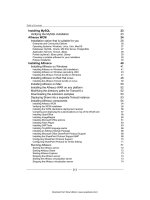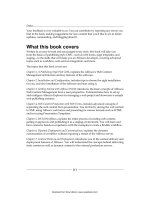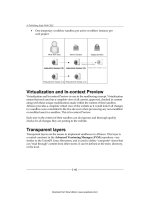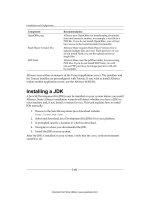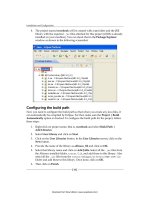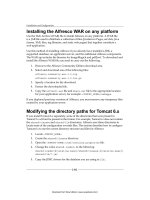Quản lý cấu hình web - part 4 docx
Bạn đang xem bản rút gọn của tài liệu. Xem và tải ngay bản đầy đủ của tài liệu tại đây (5.75 MB, 10 trang )
A Publishing Style Web CMS
[ 12 ]
• One temporary workow sandbox per active workow instance per
web project:
Virtualization and In-context Preview
Virtualization and In-context Preview is core to the sandboxing concept. Virtualization
means that each user has a complete view of all current, approved, checked in content
along with those unique modications made within the context of their sandbox.
Alfresco provides a complete virtual view of the website as it would look if all changes
in a sandbox were committed to the live site even when previewing any non-modied
or modied asset in a sandbox. This is In-context Preview.
Each user in the context of their sandbox can do rigorous and thorough quality
checks for all changes they are posting to the website.
Transparent layers
Transparent layers are the means to implement sandboxes in Alfresco. This layer is
a central construct in the Advanced Versioning Manager (AVM) repository, very
similar to the UnionFS Linux lesystem, and is used to dene "composite" stores that
can "read through" content from other stores. It can be dened at the store, directory,
or le level.
Download from Wow! eBook <www.wowebook.com>
Chapter 1
[ 13 ]
From Alfresco 3.1 onwards, transparent layers can be congured by a Content
Manager in the Staging Sandbox of a web project. This is useful for:
• Dening web project templates
• Reusing content across multiple web projects
• Explicitly segregating different groups of content producers for separate
web projects
Web forms
Web forms are used in Alfresco WCM to capture content from the user, and store
as XML. An XML schema needs to be created by form developers for capturing
content. It is then rendered automatically as a user-friendly web-based form for
content contributors.
Alfresco uses the open source project Chiba, an XForms implementation used to
transform the XML schema into an internal representation of a form (XForms), and
then present UI controls for elements and attributes described in the schema. This
helps to render the form entry UI to the end users.
Web forms are created and administered in the Web Forms space within the Data
Dictionary. As they are located in Alfresco Spaces, they are accessible by the default
CIFS, FTP, and WebDav interfaces. They can also be congured with rendering
engine templates for generating renditions of the collected content.
Rendition templates
The web form-managed XML can be transformed with rendition templates and the
corresponding content into rendered output. Server-side templating languages,
such as FreeMarker, XSLT, and XSLT-FO are provided by Alfresco. After a content
item (XML le) is created via a web form, each rendition template congured for
that content type is executed, producing an output le per template (shown in the
following diagram). Typical formats for renditions of web content include HTML,
JSP, PDF, XML, and so on:
Download from Wow! eBook <www.wowebook.com>
A Publishing Style Web CMS
[ 14 ]
Web scripts
Web scripts provide RESTful access to content held within your Alfresco Enterprise
Content Repository. You can therefore place controls on your enterprise content to
manage it, and provide uniform access for a wide variety of client applications and
services, such as browser, portal, search engine, or any custom application.
Web scripts allow you to:
• Easily access, manage, and cross-link your content via a customized RESTful
API. You do not need any compilation, generators, server restarts, complex
installs, tooling, or Java knowledge. All you need is your favorite text editor
or the Alfresco Explorer web client.
• Build custom URI-identied and HTTP-accessible Content Management
Web Services.
• Turn your Alfresco repository into a content management-powered
HTTP server.
Workows
Alfresco WCM uses JBoss jBPM for all workows. There are three aspects of
workows in Alfresco:
• Workow denition: The creation and deployment of the jBPM workow
into Alfresco repository.
• Workow association: The assignment of a workow to a web project, which
specify the actors (reviewers identied).
• Workow instance: Created when content that is specic to the associated
change set is submitted. Additionally, Alfresco comes with Web Site
Submission workow out of the box, which allows for serial and parallel
approval of content.
Content delivery concepts
In Alfresco there are three delivery models: static, dynamic, and a hybrid of both
static and dynamic. In a static delivery model, all requests to the web server return a
static le of XHTML, XML, JSON, and so on to the web client without any additional
processing (no CGIs, no SSI, and so on).
In a dynamic delivery model, all requests to the web server return objects of type
XHTML, XML, JSON, and so on that are processed by some application server to
render the resulting document.
Download from Wow! eBook <www.wowebook.com>
Chapter 1
[ 15 ]
Static delivery model
In such a model, pages are rendered as part of the content production process. The
resulting HTML and associated assets (images, CSS, JS, and so on) are then published
to the lesystem, typically a document root of a web server. This provides high
levels of scalability on simplied production architectures (web server farms). This
model, however, has limited personalization and there is a set number of rendering
technologies (FreeMarker, XSLT, and XSLT-FO).
A File System Receiver (FSR) will need to be installed and congured to receive
published static content from the Alfresco server. The FSR consists of a small server
that receives updates from an Alfresco repository and publishes them to a at
lesystem, which is then typically served up by a web or application server. The
following diagram illustrates this process:
Dynamic delivery model
A pure dynamic model publishes content to an Alfresco Runtime, thereby making
the content available for dynamic queries with basically any web technology (PHP,
Python, J2EE, AJAX, Flash, Cold Fusion, and so on). This provides ultimate exibility
in what and how content is displayed on a page. This provides the highest levels
of personalization, but will require signicantly more resources on the delivery
servers for similar levels of trafc. For all but the smallest websites, signicant effort
is required in architecting, developing, and testing to ensure website or application
stability. This is particularly the case during unexpected high-volume situations (for
example, a Government website during a national disaster). The following diagram
illustrates the dynamic delivery model:
Download from Wow! eBook <www.wowebook.com>
A Publishing Style Web CMS
[ 16 ]
An Alfresco System Receiver (ASR) will need to be installed on a server to facilitate
the dynamic delivery model. The ASR is just another instance of the Alfresco server.
The ASR allows a web project being authored in one Alfresco server instance to be
deployed to another separate instance of Alfresco.
Overview of delivery models
The following is a summary of static and dynamic delivery models:
Static "Bake" Model Dynamic "Fry" Model
Delivery technology Web servers Application servers
Page compositing Submission time Request time
Content deployed to Filesystem Alfresco runtime
Personalization Limited Unlimited
Performance Ultimate Less than the "bake" model
Application developer skill sets FreeMarker, XSLT,
XSLT-FO
Any web technology
The best of both worlds
A hybrid approach is the preferred approach regardless of the WCMS and the
underlying technologies. Determination of what is static and what is dynamic is
highly dependent on the type of website and web applications.
Download from Wow! eBook <www.wowebook.com>
Chapter 1
[ 17 ]
Users also have the option of a hybrid delivery approach. This approach can be
executed as follows:
• The web architecture model should be designed to support the dynamic
model. This includes the ability to deploy content to both lesystems and
Alfresco runtimes for exibility.
• Leverage the static model wherever possible. If content must be personalized
to a single user or a very small set of users with few "page" impressions, it
most likely needs to be dynamic. Otherwise, it can be static.
• Choose a page composition model appropriate to the overall site and each
page on the site:
° Outside-in: Each page is static HTML with static components already
embedded, but dynamic components or applications such as AJAX
and Flash can be included.
° Inside-out: Each page is dynamic and includes all page components
dynamically regardless of whether those components are static
or dynamic.
Signicant enhancements in Alfresco
WCM with Version 3.3
A bunch of new features focused on helping companies manage their web presence
have been introduced in Version 3.3. A list of these is as follows:
• Alfresco Web Editor: In-context editing to Alfresco (non-AVM) stored
content has been introduced. This will allow content authors to edit content
items stored within an Alfresco repository directly from the web page.
Alfresco 3.3 also provides the Web Editor Framework, a JavaScript client-side
framework, rendering a toolbar, and associated controls.
• Transfer Service API: Developers can build solutions that transfer content
between Alfresco repositories (non-AVM) using the Transfer Service API.
This is useful to WCM architectures where Alfresco provides both authoring
and delivery tier components and allows rich-content structures and
relationships to be maintained between Alfresco environments.
• Rendition API: The Rendition API will allow developers to build solutions
for easily repurposing content for the Web. FreeMarker and XSLT templates
can also be used as part of the Rendition API.
Download from Wow! eBook <www.wowebook.com>
A Publishing Style Web CMS
[ 18 ]
• WCM deployment: The Alfresco Deployment Receiver is congured as
sub-system and a new Data Dictionary folder called Web Deployed
is congured to default as the deployment target. AVM to DM-WCM
deployment facilities have been enhanced to add an additional deployment
target. This additional deployment receiver allows WCM content that is
authored and stored within the AVM to be deployed to local and remote
Alfresco repositories (Alfresco DM).
Alfresco Web Editor
The Alfresco Web Editor (AWE) is a Spring Surf-based web application that utilizes
the Forms Service to provide in-context editing capabilities to Alfresco repository
content (non-AVM). Alfresco 3.3 also introduces the Web Editor Framework (WEF),
which is a client-side JavaScript framework that is a dependency of the AWE.
With the initial release, the AWE will support JavaServer Pages (JSP)-based websites
by providing a tag library. Additional languages will be supported in future releases
with FreeMarker and PHP being on top of the list. The tags have been designed for
easy implementation so that a developer can enable the AWE with minimal effort,
and without effecting the CSS layout and design of the site.
The simplest and quickest way to deploy AWE is to use the prebuilt WAR (awe.war)
le and deploy it in the same application server instance of your web application.
Being a Spring Surf-based application, AWE does not have to be deployed in the
same application server instance as the Alfresco repository. However, this section
presumes that it is.
Download from Wow! eBook <www.wowebook.com>
Chapter 1
[ 19 ]
Summary
An easily navigated site, with information consistently organized in a logical
fashion, is what most organizations want to provide. But delivering consistent
organization with proper adherence to corporate branding and design standards
can be difcult when several authors are contributing content. If more than one
designer or Webmaster posts content, standards can easily become compromised
and consistency diminished.
In this chapter, we have learned that Alfresco gives you a web content management
solution that:
• Has content component architecture where content is separated from format;
it is easier to reuse.
• Uses an open, object-based API—an open interface providing compatibility
with new or emerging technologies.
• Is an open source alternative.
The next chapter focuses on installing Alfresco and various components around it.
Installation on various operating environments is detailed therein. Also explained
is the installation of various components like OpenOfce, ImageMagick, Microsoft
Ofce Add-ins, Flash Player, and SWFTools.
Download from Wow! eBook <www.wowebook.com>
Download from Wow! eBook <www.wowebook.com>
Installation and Conguration
This chapter is aimed at enabling you to understand and carry out various aspects
of the Alfresco WCM installation and conguring various components around it.
A basic understanding of Alfresco architecture, various installation options, and
the key terminologies used are all a part of this chapter. The Alfresco development
environment needs to be set in place before we can work with the tools.
The installation procedures can also vary depending on the kind of system you have
in place to set up and congure Alfresco. First, we will go through the installation
procedures for a Microsoft Windows-based system. Linux-based systems also follow
similar steps. We will go into detail later in the chapter.
At the end of this chapter, you will have learned the following:
• Components to install
• Conguring the Alfresco Setup
• The WCM Component
• Setting up the Alfresco WCM development environment
Following is the list of softwares you need on your machine before you
install Alfresco:
Component Recommendation
Java SE Development Kit (JDK) JDK 6 is required.
Database Alfresco comes precongured with the MySQL
database. If you intend to use a different database,
install and congure the database before you
install Alfresco.
Download from Wow! eBook <www.wowebook.com>

